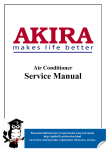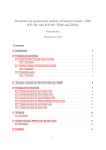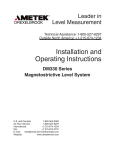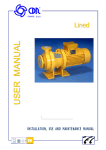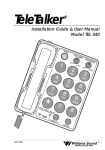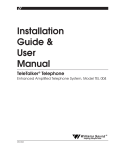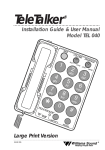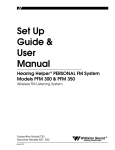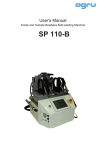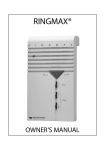Download Vial Cleaning System Manual
Transcript
Vial Cleaning System User’s Manual -1- The vial cleaning system provides the safest and most efficient method for heated soaking and cleaning PFA vials and labware. It is designed to be a direct replacement for glass beakers used by many labs for this process. Materials of Construction • • • ECTFE (sealing ring) PTFE (filter membrane and retaining ring in ¼” vent nut assembly) PFA (all other parts) Liability Disclaimer Every effort has been made in the preparation of this publication to provide the user with the most current, correct and clearly expressed information and instructions required for use and operation of the vial cleaning system. Savillex Corporation assumes no liability or responsibility for damages resulting from errors, omissions and accuracy of the information in this manual. The information included has been compiled from a variety of sources and is subject to change without notification. Savillex Corporation makes no warranties or representations regarding the quality, content, completeness, suitability, adequacy, sequence, accuracy, or timeliness of such information. If you discover any errors or omissions we encourage you to contact Savillex immediately. 1 Unpacking and Inspection 2 Open the shipping carton and remove the vial cleaning system. Note that some parts are inside the cleaning container. Check all of the components against the below packing list and inspect for shipping damage such as cracks, scratches, dents, etc. Should any components be missing or damaged, contact your local distributor or Savillex. 7 3 6 4 Danger Categories and Signal Words Signal words described below are highlighted in boldface and used in connection with warnings throughout this manual. For your own safety and to avoid property damage, please observe these warnings! DANGER! Denotes most severe hazards. Failure to follow safety instructions is likely to cause severe personal injury, death or severe property damage. WARNING! Denotes less severe hazards. Failure to follow safety instructions may cause severe personal injury, death or severe property damage. Qualified Users This product is intended as an experimental tool for research and development in the laboratory by qualified analytical chemists. Only those individuals that have adequate technical training, knowledge and demonstrated expertise should use it. Observe all safety procedures and best laboratory practices to assure safe operation. As in all laboratory operations, the user must assure that adequate safety procedures are established to protect all personnel from the potential hazards in the use of this product. Specifications Description 5 System Components Included Description Part Number 1. Pour Spout Assembly 550-740-400837 2. Sealing Ring 550-740-400823 3. ¼” Vent Nut Assembly 550-740-300731 4. Cleaning Container 550-740-400840 (1/2”ferrule nut, 3/8” cap nut, pour spout) (1/4”vent nut, 9 mm PTFE membrane, PTFE retaining ring) 5. Silicone Grip Mat 730-0060 6. Cleaning Container Lid 550-740-400817 7. ½” Cap Nut, Cleaning Container 550-740-600586 Measurement Vial Cleaning System Diameter (with lid) 185 mm (7.28 in) Vial Cleaning System Height (with pour spout) 400 mm (15.75 in) Vial Cleaning System Empty Weight (with pour spout) 2,100 g (4.63 lbs) Brim Capacity 4,500 mL (1.2 gal) Maximum Temperature Rating (hotplate setting) Pressure Rating 450°F (230°C) Spare Parts Sold Separately Description Part Number 3/8” Knurled Ferrule Cap Nut 750-FP6 (Used to close pour spout assembly) ½” Ferrule Nut, Cleaning Container (Used to attach pour spout assembly to cleaning container lid) 1 PSI at 75°F (23°C) -2- -3- 550-740-400835 Guidelines for Use Opening the Vial Cleaning System 1. Place the silicone grip mat on a flat, rigid surface 2. Place the closed/sealed cleaning container on the silicone grip mat 3. Place both hands on the sealing ring and press downwards 4. Turn the sealing ring in a counter-clockwise direction until removed Closing the Vial Cleaning System 1. Place the silicone grip mat on a flat, rigid surface 2. Place the cleaning container on the silicone grip mat 3. Place the cleaning container lid on top of the cleaning container 4. Thread the sealing ring onto the cleaning container in a clockwise direction until the sealing ring makes face contact with the cleaning container lid 5. Place both hands on the sealing ring, press downwards and turn clockwise until you cannot rotate the sealing ring any further (approximately ¼ turn more) Filling the Vial Cleaning System DANGER! Take appropriate precautions during filling with and dispensing of acid. Always wear recommended safety apparel when handling or working with acids. In case of contact, flush with copious quantities of water. See reagent manufacturer’s material safety data sheet (MSDS) for safe handling instructions. 1. Place items to be cleaned inside the cleaning container 2. Place the cleaning container on the silicone grip mat 3. Fill the cleaning container with cleaning solution to a level not to exceed the external flange ring 4. Place the cleaning container lid on top of the cleaning container 5. Follow the previously prescribed closing instructions to seal the vial cleaning system 6. Make sure that the ½” cap nut and ¼” vent nut assembly are securely tightened NOTE: Alternatively, you may install the pour spout instead of the ½” cap nut and use the 3/8” cap nut on the pour spout to close/seal the vial cleaning system. Refer to the section on emptying the cleaning container for installing the pour spout assembly. -4- Handling the Filled Vial Cleaning System DANGER! Take appropriate precautions during filling and dispensing of acid. Always wear recommended safety apparel when handling or working with acids. In case of contact, flush with copious quantities of water. See reagent manufacturer’s material safety data sheet (MSDS) for safe handling instructions. 1. Place both hands around the middle of the sealed cleaning container 2. Slide both hands upward until you contact the external flange ring 3. Securely grasp the cleaning container with hands at this location and lift to transfer Heating the Vial Cleaning System The vial cleaning system should ONLY be operated under an acid fume hood. Although the liquid will remain fully contained within the cleaning container, some acidic vapors will be released through the vent opening in the cleaning container lid. WARNING! Do not use the vial cleaning system on a hotplate surface above 450°F (230°C). Exceeding this temperature may cause irreversible damage to the vial cleaning system. 1. Securely transfer the filled and sealed vial cleaning system to the hotplate 2. Make sure that the vent nut assembly is installed and secured. Never plug the vent port while heating 3. Use the recommended hotplate temperature settings below to achieve your desired internal liquid temperature. NOTE: Internal liquid temperature may vary depending on the liquid used for cleaning (i.e. acid concentration) Hotplate Temperature Setting Approx. Internal Liquid Temperature Approx. Time to Reach Internal Liquid Temperature 392°F (200°C) 194-212°F (90-100°C) 8 Hours 320°F (160°C) 158-176°F (70-80°C) 4 Hours 4. Because of the possible variability of hotplate surface temperature, we recommend that you verify the surface temperature with a thermocouple to prevent overheating and damaging the vial cleaning system -5- 5. Due to the thermal insulation properties of PFA, the hotplate temperature setting will need to be higher than the desired internal liquid temperature in order to obtain the desired internal liquid temperature WARNING! Do not use the vial cleaning system on a hotplate surface above 450°F (230°C). Exceeding this temperature may cause irreversible damage to the vial cleaning system. 6. At the end of the desired heating time, remove the vial cleaning system from the hotplate and allow the contents to cool to room temperature DANGER! The vial cleaning system will be hot to the touch. Wear appropriate personal protective equipment when handling. NOTE: The vent nut assembly, while allowing gas to escape will retain acid vapors inside the vial cleaning system. The vial cleaning system can be heated for several days without losing a significant amount of liquid volume to evaporation. WARNING! Do not attempt to remove the threaded sealing ring or cleaning container lid while heating or when hot. Although the container vents through the vent nut assembly, a small amount of pressure and acid vapor may build up inside the vial cleaning system. Emptying the Vial Cleaning System DANGER! Take appropriate precautions during filling with and dispensing of acid. Always wear recommended safety apparel when handling or working with acids. In case of contact, flush with copious quantities of water. See reagent manufacturer’s material safety data sheet (MSDS) for safe handling instructions. 1. Allow the vial cleaning system and contents to reach room temperature 2. If the pour spout assembly was not previously installed, remove the ½” cap nut from the lid and attach the pour spout assembly • Slide ½” fitting onto tube past groove • Insert grooved tube end into port fitting until it bottoms out • Thread ferrule nut to port fitting and hand tighten • Pull on tubing SLOWLY until you feel the ferrule catch on the grooved edge • Re-tighten the fitting hand tight 3. Remove the 3/8” knurled ferrule cap nut from the end of the pour spout assembly -6- 4. Securely grasp the cleaning container with both hands as previously described and tilt to pour into an approved collection vessel • Loosening the vent nut assembly will allow the contents to empty faster • It is not necessary to remove the vent nut assembly completely as the holes in the side of the nut allow air to enter the vial cleaning system 5. Open the vial cleaning system as previously described and carefully remove the contents Service and Maintenance The vent nut assembly (P/N 550-740-300731) is the only part that requires any maintenance. The complete vent nut assembly is easily removed and should be replaced periodically as determined by the cleanliness of your application. Do not allow the vent nut assembly to become dirty or clogged. Warranty and Liability LIMITED WARRANTY Savillex Corporation (Savillex) warrants its products against defects in materials and workmanship for 90 days from the time of shipment. Savillex makes no warranty, express or implied, with respect to any components, products, information or services provided by any third party. Upon Savillex’s confirmation of defects, Buyer’s EXCLUSIVE REMEDY shall be for Savillex, at Savillex’s option and subject to return of the defective product, to repair or replace the defective product or to refund the price paid by Buyer for such product. Warranty coverage excludes product damage which Savillex determines is due to accident, misuse or lack of reasonable care. Buyer’s warranty rights are subject to Savillex being promptly notified in writing upon discovery of a warranty claim with a detailed explanation of the defect, and the claimed defective product being received by Savillex, freight prepaid, within 30 days after expiration of the warranty period. EXCEPT AS STATED IN THIS DOCUMENT, NO OTHER WARRANTY, EXPRESS OR IMPLIED, IS GIVEN OR AUTHORIZED BY SAVILLEX. IMPLIED WARRANTIES OF MERCHANTABILITY AND FITNESS FOR A PARTICULAR PURPOSE ARE EXPRESSLY DISCLAIMED. LIMITATION OF LIABILITY SAVILLEX DISCLAIMS AND IS NOT LIABLE FOR ANY SPECIAL, INDIRECT, INCIDENTAL OR CONSEQUENTIAL DAMAGES OF ANY NATURE OR TYPE, WHETHER ARISING OUT OF WARRANTY OR OTHER CONTRACT, NEGLIGENCE OR OTHER TORT, OR OTHERWISE, INCLUDING WITHOUT LIMITATION, FORESEEABLE LOSS, LOST PROFITS AND RELIANCE DAMAGES. IN NO EVENT SHALL SAVILLEX’S LIABILITY UNDER ANY CAUSE OF ACTION RELATING TO A PRODUCT EXCEED THE PURCHASE PRICE OF THE PRODUCT. Visit www.savillex.com for complete sales terms and conditions. -7- Savillex Corporation 10321 West 70th St. | Eden Prairie, MN 55344-3446 USA Phone: 952.935.4100 | Fax: 952.936.2292 Email: [email protected] www.savillex.com -8- SM002 020515





